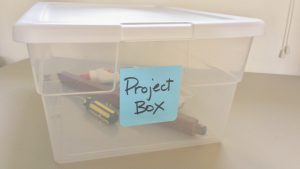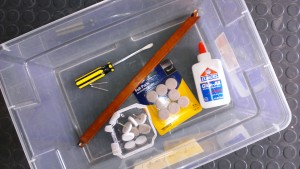Why you need a Project Box & a Master To-Do List
Do you have unfinishe d household projects lying around? I can tell what my clients’ projects are at a glance – there are light bulbs that need changing; clothing that needs repairing; pictures that need to be framed and hung; and gifts that need to be wrapped. They are sitting out on the counters, tables, and floors, all waiting to be done. But they aren’t getting done. Why not?
d household projects lying around? I can tell what my clients’ projects are at a glance – there are light bulbs that need changing; clothing that needs repairing; pictures that need to be framed and hung; and gifts that need to be wrapped. They are sitting out on the counters, tables, and floors, all waiting to be done. But they aren’t getting done. Why not?
Have you become clutter-blind?
Unfinished projects often become a pile of clutter. Sometimes we forget all about a project despite the fact that it is sitting right there in plain sight. That’s because we become “clutter-blind”. The project becomes lost in the “visual noise”, and our brain simply doesn’t register it anymore. Or, it disappears under a pile of other stuff we intended to do.
Another reason these projects don’t get done is that we don’t set aside time for doing them. Why not schedule time on your calendar? The things we schedule are more likely to get done. The items on the counter could theoretically serve as a visual to-do list, but that only works if you have only one project to focus on; and your home is otherwise clutter-free (so you notice the project sitting there); and if you consistently follow through on your intentions (so it doesn’t sit there forever).
My clients are afraid they’ll forget to do the projects if they don’t leave the items sitting out where they can see them. They want to do the projects, but they are overwhelmed, just as list-makers get overwhelmed when they have a written to-do list a mile long. It’s overwhelming because there is no way to do everything on the list in one day…or week…or month…or year…
So, what is the solution? A Project Box and a Master To-Do List!
Here’s how it works:
Step 1: Corral the Clutter
Corral small items pertaining to projects into a Project Box. Examples: The screws, screwdriver, glue, and felt pads you are going to use for refurbishing your dining room chairs this weekend…and the new electronic gadget you just bought and the instructions you need to read but don’t have time for today…and the gift, wrap, and card you want to write and mail to your niece before graduation day. I use a 16 qt. Sterilite plastic bin, which is plenty big for a number of small projects. Ziploc bags are great for keeping small parts together. Some projects will be too big for the Project Box and may require a larger bin, or shelf, or closet. Even so, you don’t need to leave projects sitting out unless you are actively working on them. If you follow the rest of these steps, your projects will be out of sight, but not out of mind!
Corral your clutter and free your mind! Click To TweetStep 2: Add it to Your Master To-Do List
New Rule: Nothing goes into the Project Box (or gets stashed elsewhere) without adding the project to your Master To-Do List!!! Yes, this is the list that can seem overwhelming if you look at it every day, and feel bad that all the items aren’t completed. But I suggest you think of your Master To-Do List as merely a tool for capturing ideas…and tasks…and projects that have yet to be planned out by breaking them down into smaller tasks. It is a living document that will, and should, always be long and ever-changing! It does not matter whether it’s an electronic list or a handwritten one. The more thoughts you can capture, the more your mind can relax and not worry about having to remember everything. A relaxed mind is what will allow you to enjoy your daily activities more, whether they are things you have to do, or things you want to do.
Step 3: Make a Short Daily To-Do List
Each day choose just a few things to actually do. Say, 3-5 things including appointments. Maybe you want to choose something from each of your major life categories, as I described in The Chinese Menu Time Management Technique . It depends on what sorts of things you need to do, and how you like to count them. (I might count “run errands”, as one item. You might count all the stops you need to make as individual items.) The point is: If you only “bite off as much as you can chew” in a day, you will feel a sense of accomplishment almost every day! If you find you’ve completed your short list early, go ahead and choose another task, or take the opportunity to relax.
Step 4: Review Your Master To-Do List Weekly
You can glance at your Master To-Do List if you need to, to remind you of urgent items for your Daily To-Do List, but a weekly review is usually sufficient, and crucial for not forgetting what’s on there. If you never look at your Master To-Do List it will be no different from having stuff piled on the counter and not registering what’s there anymore. Schedule a weekly planning session with yourself — yes, on your calendar — and set a recurring alarm reminder, if that’s what it takes. Take a few moments while you’re at it to break down a project into smaller, more do-able tasks. Schedule some tasks on your calendar. Make this weekly planning session with yourself more fun by choosing a comfy chair and sipping a delicious beverage, or taking yourself to a coffee shop or other relaxing spot you enjoy.
To avoid feeling overwhelmed, refer to your Master To-Do List weekly, not daily. Click To TweetStep 5: Remember, You Don’t Have to Actually Do Everything on Your List!
Each time you review your Master To-Do List you have an opportunity to select something that you want to work on…as well as an opportunity to decide NOT to do something after all. Ask yourself: Is it Really Worth Doing? Think “Do, Delegate, or Dump”. Sometimes Doing looks like completing a quick task just to get it over with, like changing that light bulb. Other times Doing means putting in regular chunks of time on an ongoing project like exercising, studying, or writing. But Delegating a task to someone else, or Dumping it altogether, are equally valid ways to get something off your list. Just because you put it on the list doesn’t mean you have to do it!
The key to feeling productive and happy is to Do only tasks and activities that support your goals and priorities, and to Delegate or Dump the rest.
It also helps if you know how to set S.M.A.R.T. goals.
What sorts of projects do YOU have sitting out so you can see them?
Do you think a Project Box and a Master To-Do List would help you to control clutter and get things done?
Please leave a comment below and share with your friends!
—————————————————————————
Copyright 2014-2019 by Hazel Thornton, Organized For Life.
Social media links directly to this page are encouraged!
Please contact me for other types of reprint permission.
—————————————————————————
Share this:






I use my To Do list faithfully, and take time to review it at the end of each week, but I’ve never heard of a project box, at least not in this context. What a fantastic idea!
Apparently I never replied to this comment. I wonder if you have been using a project box since then, Janet?
I would have to say no, but mainly because I don’t really have any projects – unless you count knitting. I have a knitting basket which holds all the supplies I need for whatever I’m working on, including my knitting book in case I need to look something up.
I love using using Ziploc bags for organizing projects. I like the 2 gallon size and the XL and XXL bags (which I purchase on-line.) I have used them for everything from knitting yarn to cabinet hardware to paperwork. They keep materials clean and they are portable, too.
Oh, me too! And with Ziplocs containing/separating individual projects you can fit a number of them into a Project Box!
“To Do, Delegate, or Dump List” – Love it!!! The perfect mental nudge for dealing with unfinished projects. Allusion with alliteration, fabulous!
Also, thanks for the reminder to keep a master list separate from the daily list. My husband and I used a similar technique when we were getting our boat ready to sail for a 3 year cruise. I don’t know why I didn’t adapt the practice for the rest of my life!
Thank you!
I can only imagine the planning it took to prepare for a 3 year cruise! Are you going to start keeping a master list and a separate daily list in your regular life now?
Like yours, so many of my clients want that visual cue to remind them to handle projects and tasks. But as you so beautifully pointed out, we can quickly become clutter blind, especially if there is already a lot of “noise.” Also, without connecting a project or task to a to-do item, the likelihood of getting it done substantially decreases. There are times when visual clues do work for me like when I hang something on the doorknob, so I remember to take it out. But generally, as you suggested, I use the tag-team method. Put the “project” in an out of the way location and connect the doing with a specific date on my list.
I love your comment about not having to do everything on your list. The key to the list is to have a method for remembering what needs to get done. Prioritizing the list helps you do what is most important. Allowing yourself to move uncompleted items to other days is such a freeing mindset, as is only checking the master list weekly. It can be so easy to get overwhelmed when you can’t see how you will possibly get everything done. It’s almost like putting blinders on the horses in Central Park. Focus on the next step.
Great tips, Hazel! I have a place on my small command area that is just for to-dos. Right now, it holds my “to be donated” prescription eyeglasses. This area is my zone and to-dos for the week are stored/displayed here. So, seeing it there while planning the week helps remind me what needs to be done.
When I have more than one thing to do, on Friday, I write up the to-dos for the weekend on a post-it and stick it to the back of my phone. It is distracting enough that I can’t forget the list anywhere. When it is done, I get rid of the sticky note. YAY.
What a great system! I like using project boxes for my speaking presentations as a place to collect resources and notes and props. Also, I designate Friday as Finish it Friday to complete any unfinished tasks for the week. And thanks for giving all of us permission to delete things from our lists. Writing it down gets it out of my head & seeing it on paper helps me to evaluate better whether is really important to me.
Hi Olive — I, too, have a box for presentation materials. And I love “Finish it Friday”! Thanks for sharing.